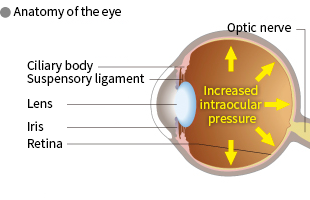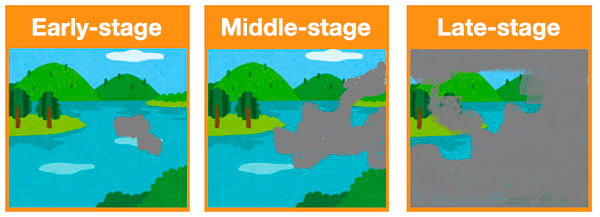About glaucoma
Glaucoma is an eye disease in which increased intraocular pressure causes damage to the optic nerve, causing the visual field to narrow. Increased intraocular pressure compresses the optic nerve.
The role of this nerve is to deliver visual information entering the eye to the brain. However, pressure causes damage to the optic nerve, making it difficult to convey visual information effectively. As a result, vision deteriorates in the damaged areas, and the person’s field of view narrows. Severe cases of glaucoma can lead to blindness.

Changes in the visual field

What kind of person develops glaucoma?
According to a detailed epidemiological survey of glaucoma conducted from 2000 to 2002 in Japan , the prevalence of glaucoma in persons over 40 years old was reported to be 5.0%. This means glaucoma is a common disease, affecting 1 in 20 people in this age range. In its early stages, glaucoma has few subjective symptoms. Moreover, the disease progresses gradually, so it is difficult for a person seeing out of both eyes to notice any difficulty in seeing from one eye. The number of patients who actually receive treatment is small; it is thought that the population of potential glaucoma patients ranges from 3.5 to 4 million people.

How is glaucoma treated?
There is currently no way to recover vision lost due to glaucoma. Early detection is important, therefore, to stop further progression of the disease.
Treatments include drug treatment and surgery. Of these, drug treatment is the first choice in treating glaucoma. Eye drops are the main treatment.

Product information
DWTI is conducting R&D into glaucoma drugs.
For details on product development, please click the link below.

